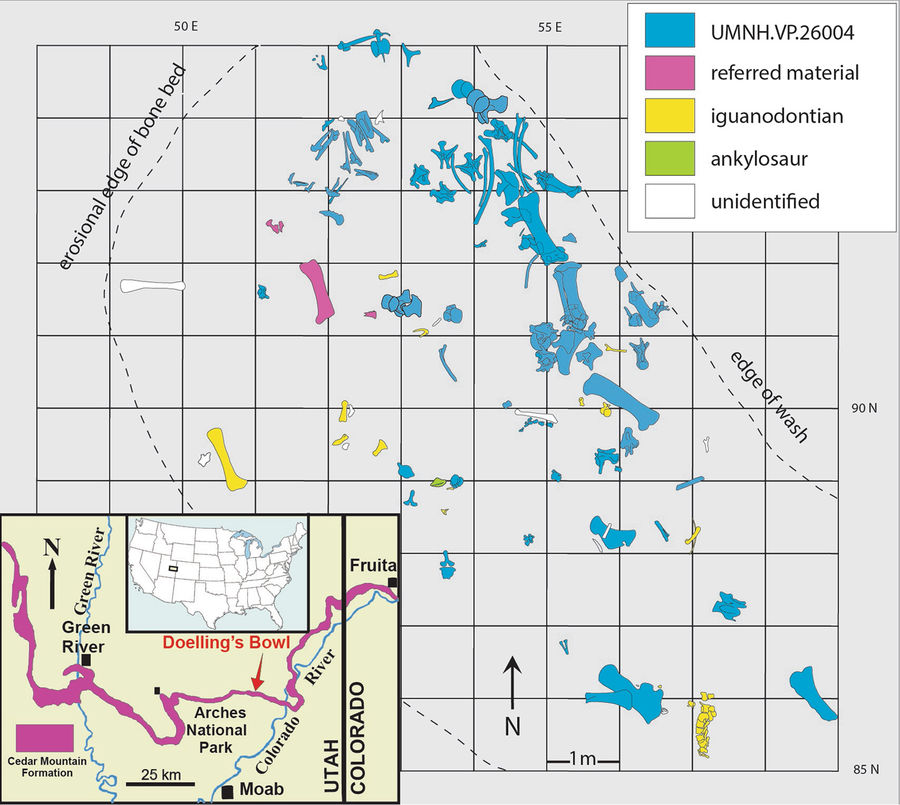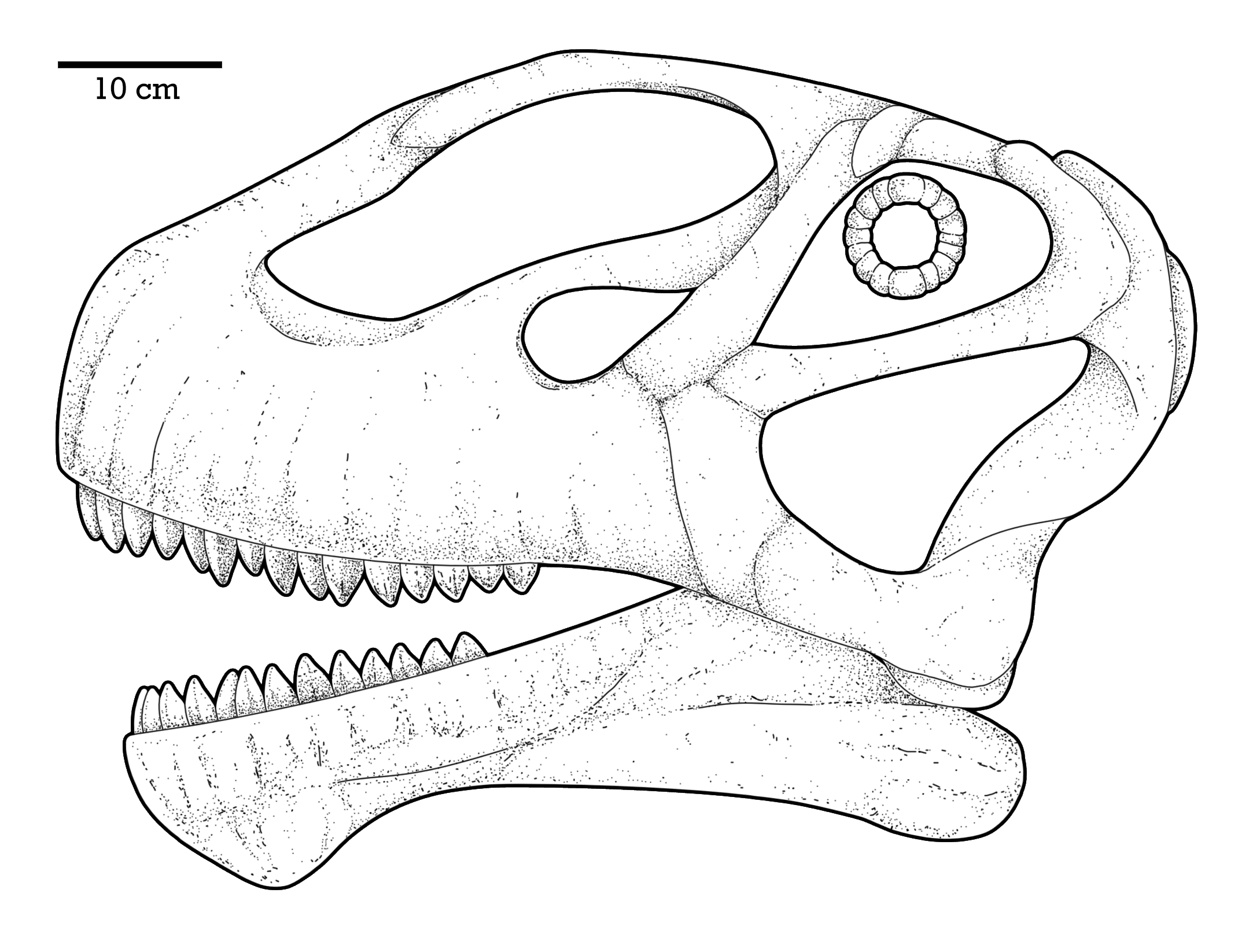|
Mierasaurus
''Mierasaurus'' is an extinct genus of sauropod dinosaur from the Early Cretaceous of Utah, United States. The taxon was first described and named in 2017 by Rafael Royo-Torres and colleagues, from a mostly complete skeleton including a disarticulated partial skull and mandible, teeth, multiple vertebrae from along the length of the body, both scapulae, radius and ulna bones, a left manus, a complete pelvis, both femora and the entire left hindlimb. Additionally, they referred a lower jaw and femur from juvenile individuals, which were found nearby, to the genus. Collectively, ''Mierasaurus'' is among the most completely known North American sauropods. The genus name honours Bernardo de Miera y Pacheco, the first European scientist to enter what is now Utah. The type species for ''Mierasaurus'' is ''Mierasaurus bobyoungi'', named after Robert Glen Young, a paleontologist who researched the Early Cretaceous of Utah. Along with its closest relative ''Moabosaurus'', also from the ... [...More Info...] [...Related Items...] OR: [Wikipedia] [Google] [Baidu] |
Mierasaurus Excavation
''Mierasaurus'' is an extinct genus of sauropod dinosaur from the Early Cretaceous of Utah, United States. The taxon was first described and named in 2017 by Rafael Royo-Torres and colleagues, from a mostly complete skeleton including a disarticulated partial skull and mandible, teeth, multiple vertebrae from along the length of the body, both scapulae, radius and ulna bones, a left manus, a complete pelvis, both femora and the entire left hindlimb. Additionally, they referred a lower jaw and femur from juvenile individuals, which were found nearby, to the genus. Collectively, ''Mierasaurus'' is among the most completely known North American sauropods. The genus name honours Bernardo de Miera y Pacheco, the first European scientist to enter what is now Utah. The type species for ''Mierasaurus'' is ''Mierasaurus bobyoungi'', named after Robert Glen Young, a paleontologist who researched the Early Cretaceous of Utah. Along with its closest relative ''Moabosaurus'', ... [...More Info...] [...Related Items...] OR: [Wikipedia] [Google] [Baidu] |
Turiasauria
Turiasauria is an unranked clade of basal sauropod dinosaurs known from Middle Jurassic to Early Cretaceous deposits in Europe, North America, and Africa. Description Turiasauria was originally erected by Royo-Torres et al. (2006) to include ''Turiasaurus'', ''Galveosaurus'' and ''Losillasaurus'', all of which hail from the Villar del Arzobispo Formation (Tithonian-Berriasian) of Spain. Turiasuria was defined by the authors as "all Eusauropoda closer to ''Turiasaurus riodevensis'' than to ''Saltasaurus loricatus''". Cladistic analysis (Royo-Torres ''et al.'', 2006; 1927) of 309 characters and 33 taxa suggests that the turiasaurians lie outside the Neosauropoda and form a monophyletic group. The clade is diagnosed by the presence of vertical neural spines, posterior centroparapohyseal laminae on the dorsal vertebrae, the absence of pre- and postspinal laminae on the dorsal vertebrae, the absence of a scapular acromial crest, the presence of a prominent humeral deltopectoral crest, ... [...More Info...] [...Related Items...] OR: [Wikipedia] [Google] [Baidu] |
Early Cretaceous
The Early Cretaceous ( geochronological name) or the Lower Cretaceous (chronostratigraphic name), is the earlier or lower of the two major divisions of the Cretaceous. It is usually considered to stretch from 145 Ma to 100.5 Ma. Geology Proposals for the exact age of the Barremian-Aptian boundary ranged from 126 to 117 Ma until recently (as of 2019), but based on drillholes in Svalbard the defining early Aptian Oceanic Anoxic Event 1a (OAE1a) was carbon isotope dated to 123.1±0.3 Ma, limiting the possible range for the boundary to c. 122–121 Ma. There is a possible link between this anoxic event and a series of Early Cretaceous large igneous provinces (LIP). The Ontong Java-Manihiki-Hikurangi large igneous province, emplaced in the South Pacific at c. 120 Ma, is by far the largest LIP in Earth's history. The Ontong Java Plateau today covers an area of 1,860,000 km2. In the Indian Ocean another LIP began to form at c. 120 Ma, the Kerguelen P ... [...More Info...] [...Related Items...] OR: [Wikipedia] [Google] [Baidu] |
Manus (anatomy)
The manus (Latin for ''hand'', plural manus) is the zoological term for the distal portion of the fore limb of an animal. In tetrapods, it is the part of the pentadactyl limb that includes the metacarpals and digits (phalanges). During evolution, it has taken many forms and served a variety of functions. It can be represented by the hand of primates, the lower front limb of hoofed animals or the fore paw and is represented in the wing of birds, bats and prehistoric flying reptiles (pterosaurs), the flipper of marine mammals and the 'paddle' of extinct marine reptiles, such as plesiosaurs and ichthyosaurs. In cephalopods, the ''manus'' is the end, broader part of a tentacle, and its suckers are often larger and arranged differently from those on the other arms. See also *Pes (anatomy) The pes (Latin for ''foot'') is the zoological term for the distal portion of the hind limb of tetrapod animals. It is the part of the pentadactyl limb that includes the metatarsals and digits (p ... [...More Info...] [...Related Items...] OR: [Wikipedia] [Google] [Baidu] |
Cervical Rib
A cervical rib in humans is an extra rib which arises from the seventh cervical vertebra. Their presence is a congenital abnormality located above the normal first rib. A cervical rib is estimated to occur in 0.2% to 0.5% (1 in 200 to 500) of the population. People may have a cervical rib on the right, left or both sides. Most cases of cervical ribs are not clinically relevant and do not have symptoms; cervical ribs are generally discovered incidentally, most often during x-rays and CT scans. However, they vary widely in size and shape, and in rare cases, they may cause problems such as contributing to thoracic outlet syndrome, because of pressure on the nerves that may be caused by the presence of the rib. A cervical rib represents a persistent ossification of the C7 lateral costal element. During early development, this ossified costal element typically becomes re-absorbed. Failure of this process results in a variably elongated transverse process or complete rib that can be ... [...More Info...] [...Related Items...] OR: [Wikipedia] [Google] [Baidu] |
Cervical Vertebrae
In tetrapods, cervical vertebrae (singular: vertebra) are the vertebrae of the neck, immediately below the skull. Truncal vertebrae (divided into thoracic and lumbar vertebrae in mammals) lie caudal (toward the tail) of cervical vertebrae. In sauropsid species, the cervical vertebrae bear cervical ribs. In lizards and saurischian dinosaurs, the cervical ribs are large; in birds, they are small and completely fused to the vertebrae. The vertebral transverse processes of mammals are homologous to the cervical ribs of other amniotes. Most mammals have seven cervical vertebrae, with the only three known exceptions being the manatee with six, the two-toed sloth with five or six, and the three-toed sloth with nine. In humans, cervical vertebrae are the smallest of the true vertebrae and can be readily distinguished from those of the thoracic or lumbar regions by the presence of a foramen (hole) in each transverse process, through which the vertebral artery, vertebral veins, an ... [...More Info...] [...Related Items...] OR: [Wikipedia] [Google] [Baidu] |
Humerus
The humerus (; ) is a long bone in the arm that runs from the shoulder to the elbow. It connects the scapula and the two bones of the lower arm, the radius and ulna, and consists of three sections. The humeral upper extremity consists of a rounded head, a narrow neck, and two short processes (tubercles, sometimes called tuberosities). The body is cylindrical in its upper portion, and more prismatic below. The lower extremity consists of 2 epicondyles, 2 processes (trochlea & capitulum), and 3 fossae (radial fossa, coronoid fossa, and olecranon fossa). As well as its true anatomical neck, the constriction below the greater and lesser tubercles of the humerus is referred to as its surgical neck due to its tendency to fracture, thus often becoming the focus of surgeons. Etymology The word "humerus" is derived from la, humerus, umerus meaning upper arm, shoulder, and is linguistically related to Gothic ''ams'' shoulder and Greek ''ōmos''. Structure Upper extremity The upper or pr ... [...More Info...] [...Related Items...] OR: [Wikipedia] [Google] [Baidu] |
Europe
Europe is a large peninsula conventionally considered a continent in its own right because of its great physical size and the weight of its history and traditions. Europe is also considered a Continent#Subcontinents, subcontinent of Eurasia and it is located entirely in the Northern Hemisphere and mostly in the Eastern Hemisphere. Comprising the westernmost peninsulas of Eurasia, it shares the continental landmass of Afro-Eurasia with both Africa and Asia. It is bordered by the Arctic Ocean to the north, the Atlantic Ocean to the west, the Mediterranean Sea to the south and Asia to the east. Europe is commonly considered to be Boundaries between the continents of Earth#Asia and Europe, separated from Asia by the drainage divide, watershed of the Ural Mountains, the Ural (river), Ural River, the Caspian Sea, the Greater Caucasus, the Black Sea and the waterways of the Turkish Straits. "Europe" (pp. 68–69); "Asia" (pp. 90–91): "A commonly accepted division between Asia and E ... [...More Info...] [...Related Items...] OR: [Wikipedia] [Google] [Baidu] |
Jurassic
The Jurassic ( ) is a Geological period, geologic period and System (stratigraphy), stratigraphic system that spanned from the end of the Triassic Period million years ago (Mya) to the beginning of the Cretaceous Period, approximately Mya. The Jurassic constitutes the middle period of the Mesozoic, Mesozoic Era and is named after the Jura Mountains, where limestone strata from the period were first identified. The start of the Jurassic was marked by the major Triassic–Jurassic extinction event, associated with the eruption of the Central Atlantic magmatic province, Central Atlantic Magmatic Province. The beginning of the Toarcian Stage started around 183 million years ago and is marked by an extinction event associated with widespread Anoxic event, oceanic anoxia, ocean acidification, and elevated temperatures likely caused by the eruption of the Karoo-Ferrar, Karoo-Ferrar large igneous provinces. The end of the Jurassic, however, has no clear boundary with the Cretaceous and i ... [...More Info...] [...Related Items...] OR: [Wikipedia] [Google] [Baidu] |
Paleontologist
Paleontology (), also spelled palaeontology or palæontology, is the scientific study of life that existed prior to, and sometimes including, the start of the Holocene epoch (roughly 11,700 years before present). It includes the study of fossils to classify organisms and study their interactions with each other and their environments (their paleoecology). Paleontological observations have been documented as far back as the 5th century BC. The science became established in the 18th century as a result of Georges Cuvier's work on comparative anatomy, and developed rapidly in the 19th century. The term itself originates from Greek (, "old, ancient"), (, ( gen. ), "being, creature"), and (, "speech, thought, study"). Paleontology lies on the border between biology and geology, but differs from archaeology in that it excludes the study of anatomically modern humans. It now uses techniques drawn from a wide range of sciences, including biochemistry, mathematics, and engineering. ... [...More Info...] [...Related Items...] OR: [Wikipedia] [Google] [Baidu] |
Type Species
In zoological nomenclature, a type species (''species typica'') is the species name with which the name of a genus or subgenus is considered to be permanently taxonomically associated, i.e., the species that contains the biological type specimen(s). Article 67.1 A similar concept is used for suprageneric groups and called a type genus. In botanical nomenclature, these terms have no formal standing under the code of nomenclature, but are sometimes borrowed from zoological nomenclature. In botany, the type of a genus name is a specimen (or, rarely, an illustration) which is also the type of a species name. The species name that has that type can also be referred to as the type of the genus name. Names of genus and family ranks, the various subdivisions of those ranks, and some higher-rank names based on genus names, have such types. [...More Info...] [...Related Items...] OR: [Wikipedia] [Google] [Baidu] |
Bernardo De Miera Y Pacheco
Bernardo is a given name and less frequently an Italian, Portuguese and Spanish surname. Possibly from the Germanic "Bernhard". Given name People * Bernardo the Japanese (died 1557), early Japanese Christian convert and disciple of Saint Francis Xavier * Bernardo Accolti (1465–1536), Italian poet * Bernardo Bellotto (c. 1721/2-1780), Venetian urban landscape painter and printmaker in etching * Bernardo Bertolucci (born 1940), Italian film director and screenwriter * Bernardo Buontalenti (c. 1531–1608), Italian stage designer, architect, theatrical designer, military engineer and artist * Bernardo Clesio (1484–1539), Italian cardinal, bishop, prince, diplomat, humanist and botanist * Bernardo Corradi (born 1976), Italian footballer * Bernardo Daddi (c. 1280–1348), Italian Renaissance painter * Bernardo Domínguez Bernardo Domínguez Fernández (born 6 July 1979), known simply as Bernardo, is a Spanish former professional footballer who played as a goalkeeper. Club ... [...More Info...] [...Related Items...] OR: [Wikipedia] [Google] [Baidu] |









_(2).jpg)